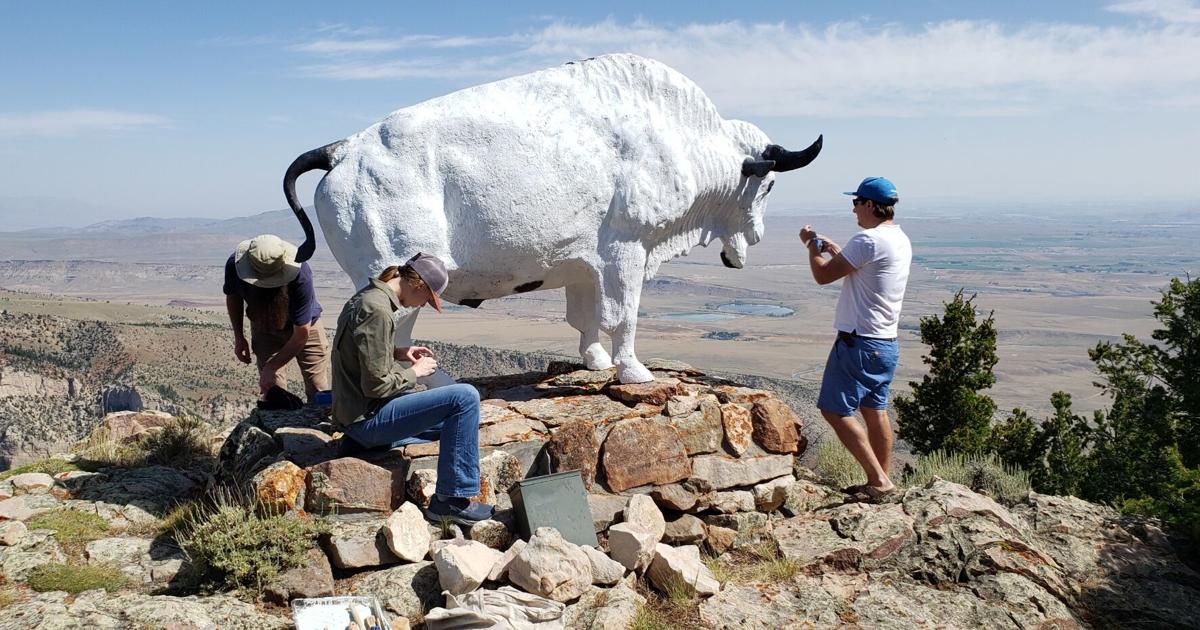When Brian Beauvais reached the top of Cedar Mountain last Friday, he remarked, with relief, “I’m happy none of the appendages are gone.”
Curator of the Park County Archives, he was coordinating a crew of volunteers to paint the repaired buffalo, a statue fabricated from fiberglass. Over its 57 years, the symbol of Buffalo Bill’s final wishes had been vandalized – including the removal of its ears, horns and tail, plus likely bullet holes – prompting Beauvais to launch the restoration project.
“In Cody’s ‘Last Will and Testament,’” Beauvais said, “he wrote of his intention of being buried atop Cedar Mountain so as to ‘lie in close proximity to that fair section of my native country which bears my name and in the growth and development of which I have taken so deep and loving an interest.’”
That sentiment struck a note with volunteer Sam Hanna, assistant curator of the Buffalo Bill Museum, who participated in the initial repair work and in the recent painting expedition. He surveyed the panoramic view from statue’s perch.
“When I first came here, seeing what Cody had written about in his 1906 will, it hit me what he meant about the Big Horn Basin,” he reflected.
In addition to honoring Cody, Beauvais envisioned the project as fulfilling several goals: to recognize the historic importance of buffalo in the Big Horn Basin, to perform a community service that celebrates local history, to promote public art, and to pay tribute to Jeremy Johnston, the late Buffalo Bill Museum curator who was involved in the initial planning.
While doing research for a map of local public art several years ago, Beauvais unearthed the statue’s origin story.
“Apparently, it was put up there in 1968 by Husky Oil to commemorate Buffalo Bill’s intended gravesite,” he said.
Beauvais also read that it was a gift of Golden, Colo., to the city of Cody to appease the townsfolk for their not having Buffalo Bill’s actual grave. The showman is reportedly buried on Lookout Mountain outside Golden.
According to an article in Points West, the magazine of the Buffalo Bill Historical Center, Husky Oil provided the helicopter that flew the fiberglass statue to Cedar Mountain on July 4, 1968, in commemoration of moving the Buffalo Bill Museum to its current location. The museum was originally housed in the building where the Cody Chamber of Commerce/Visitor Center is now located.
“I know it’s just an old fiberglass buffalo statue. But it doesn’t deserve to be vandalized and neglected” – that was the thought that motivated Beauvais’ campaign. First he researched ownership and after finding no responsible party, he sought permission to access the site across BLM and private land and then started planning repairs.
Ray Hatfield at Nature’s Design Taxidermy donated the materials and his time to fashion the ears, horns and tail, Beauvais said. The taxidermist also sent his two employees up the mountain to attach the pieces and, while there, did some patch-up work.
“The new body parts give the old buffalo a new lease on life,” Beauvais said. “Ray Hatfield did an excellent job (…) and donated his time. Matthew and Brandon from Nature’s Design Taxidermy were invaluable when it came to attaching them to the fiberglass statue.”
Last Friday, the buffalo, with attachments, greeted the paint crew – Hanna, Corey Anco, Amy Phillips, John Housel and William Frere. Anco and Phillips are, respectively, the curator and assistant curator of the Draper Natural History Museum; Housel serves on the Buffalo Bill Museum advisory board; and Frere lives in Cody and Belgium.
“I’m so grateful to everyone who has chipped in on the project. It’s been a few years in the making,” Beauvais said. “I was thrilled how eager folks were get involved and pitch in. Their involvement not only breathed new life into the statue, but also demonstrated their dedication to our local history.”
Additional help came from Park County and the Buffalo Bill Center of the West, which allowed their employees to participate. For Friday’s task, the county’s buildings and grounds department and BBCW’s maintenance department donated the paint and brushes. Housel provide a spray painter and portable generator.
“When it was placed in 1968, the statue was originally painted brown,” Beauvais related. “At some point after the installation it was repainted white. We’re not really sure why – maybe to make it more visible from below?
“We discussed whether we should repaint it white, but because we wanted to restore the buffalo to its original condition, we ultimately decided to bring back the original brown color.”
Including travel time, Friday’s task took about four hours. First, the crew taped off the horns, tail, hooves and eyes, and then applied the brown with spray and brushes. Next a darker brown went on the head and neck, after a debate about how far down the body it should extend. Finally, tape removed, the remaining parts became black.
“I was very pleased with the new paint job,” Beauvais said afterward, while wishing that an afternoon shower hadn’t affected the result.
Next, probably in early September, will be the installation of a plaque paid for by the Park County Historical Society, in remembrance of Jeremy Johnston, PhD. He was the president of the society and “very active in Wyoming historical activities,” Beauvais said. The inscription will read:
“This statue was placed in 1968 to commemorate William F. Cody’s intended gravesite atop Cedar Mountain. As Buffalo Bill embodied the spirit of the American West, so too does the buffalo – now recognized as the national mammal – symbolize that enduring legacy. In 2025, the statue was restored and rededicated in honor of Dr. Jeremy Johnston.”
Beauvais wants the work will remain intact, saying, “The old buffalo statue has stood for 57 years, and I hope it can watch over Cody for many years to come.”

